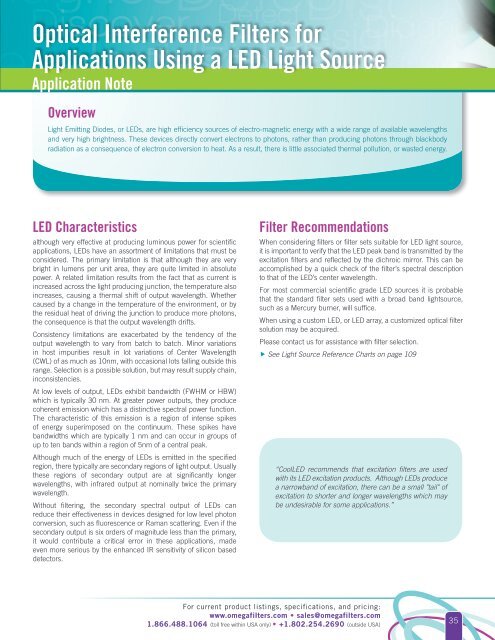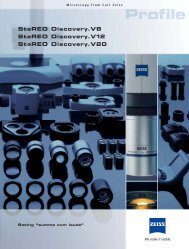optical interference filters - SPOT Imaging Solutions
optical interference filters - SPOT Imaging Solutions
optical interference filters - SPOT Imaging Solutions
You also want an ePaper? Increase the reach of your titles
YUMPU automatically turns print PDFs into web optimized ePapers that Google loves.
Optical Interference Filters for<br />
Applications Using a LED Light Source<br />
Application Note<br />
Overview<br />
Light Emitting Diodes, or LEDs, are high efficiency sources of electro-magnetic energy with a wide range of available wavelengths<br />
and very high brightness. These devices directly convert electrons to photons, rather than producing photons through blackbody<br />
radiation as a consequence of electron conversion to heat. As a result, there is little associated thermal pollution, or wasted energy.<br />
LED Characteristics<br />
although very effective at producing luminous power for scientific<br />
applications, LEDs have an assortment of limitations that must be<br />
considered. The primary limitation is that although they are very<br />
bright in lumens per unit area, they are quite limited in absolute<br />
power. A related limitation results from the fact that as current is<br />
increased across the light producing junction, the temperature also<br />
increases, causing a thermal shift of output wavelength. Whether<br />
caused by a change in the temperature of the environment, or by<br />
the residual heat of driving the junction to produce more photons,<br />
the consequence is that the output wavelength drifts.<br />
Consistency limitations are exacerbated by the tendency of the<br />
output wavelength to vary from batch to batch. Minor variations<br />
in host impurities result in lot variations of Center Wavelength<br />
(CWL) of as much as 10nm, with occasional lots falling outside this<br />
range. Selection is a possible solution, but may result supply chain,<br />
inconsistencies.<br />
At low levels of output, LEDs exhibit bandwidth (FWHM or HBW)<br />
which is typically 30 nm. At greater power outputs, they produce<br />
coherent emission which has a distinctive spectral power function.<br />
The characteristic of this emission is a region of intense spikes<br />
of energy superimposed on the continuum. These spikes have<br />
bandwidths which are typically 1 nm and can occur in groups of<br />
up to ten bands within a region of 5nm of a central peak.<br />
Although much of the energy of LEDs is emitted in the specified<br />
region, there typically are secondary regions of light output. Usually<br />
these regions of secondary output are at significantly longer<br />
wavelengths, with infrared output at nominally twice the primary<br />
wavelength.<br />
Without filtering, the secondary spectral output of LEDs can<br />
reduce their effectiveness in devices designed for low level photon<br />
conversion, such as fluorescence or Raman scattering. Even if the<br />
secondary output is six orders of magnitude less than the primary,<br />
it would contribute a critical error in these applications, made<br />
even more serious by the enhanced IR sensitivity of silicon based<br />
detectors.<br />
Filter Recommendations<br />
When considering <strong>filters</strong> or filter sets suitable for LED light source,<br />
it is important to verify that the LED peak band is transmitted by the<br />
excitation <strong>filters</strong> and reflected by the dichroic mirror. This can be<br />
accomplished by a quick check of the filter’s spectral description<br />
to that of the LED’s center wavelength.<br />
For most commercial scientific grade LED sources it is probable<br />
that the standard filter sets used with a broad band lightsource,<br />
such as a Mercury burner, will suffice.<br />
When using a custom LED, or LED array, a customized <strong>optical</strong> filter<br />
solution may be acquired.<br />
Please contact us for assistance with filter selection.<br />
See Light Source Reference Charts on page 109<br />
“CoolLED recommends that excitation <strong>filters</strong> are used<br />
with its LED excitation products. Although LEDs produce<br />
a narrowband of excitation, there can be a small "tail" of<br />
excitation to shorter and longer wavelengths which may<br />
be undesirable for some applications.”<br />
For current product listings, specifications, and pricing:<br />
www.omega<strong>filters</strong>.com • sales@omega<strong>filters</strong>.com<br />
1.866.488.1064 (toll free within USA only) • +1.802.254.2690 (outside USA)<br />
35

















